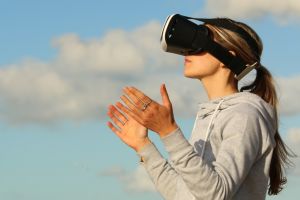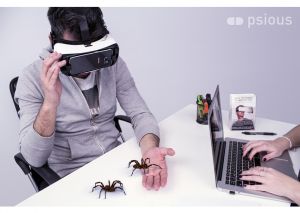 Most of us experience some level of stress and anxiety in our lives, ranging from relatively mild to extremely severe and debilitating. The 2007 National Survey of Mental Health and Wellbeing showed that almost half of Australia’s total population (45.5%) experienced a mental disorder at some point in their lifetime. Anxiety disorders are the most common, for example general stress at work, relationship issues, fears and phobias, depression and post-traumatic stress disorder (PTSD).
Most of us experience some level of stress and anxiety in our lives, ranging from relatively mild to extremely severe and debilitating. The 2007 National Survey of Mental Health and Wellbeing showed that almost half of Australia’s total population (45.5%) experienced a mental disorder at some point in their lifetime. Anxiety disorders are the most common, for example general stress at work, relationship issues, fears and phobias, depression and post-traumatic stress disorder (PTSD).
Unfortunately, technology innovation in mental health has been slower to take-off than technology in general healthcare as it faces a number of challenges around intervening in human behaviour. A local Canberra company however, is using cutting edge technology to treat anxiety disorders.
Mae van Rensburg from Brand New Mindset explains that Exposure Therapy is a technique used in behaviour therapy that treats anxiety disorders. Based on years of research, it involves exposing the patient to the feared object or context without any danger, in order to overcome their anxiety and distress.
“The use of Virtual Reality technology offers unique capabilities for the treatment of anxiety, fears and stress not only because it allows interactive, multi-sensory, immersive environments to be readily created, but also because it provides the ability for the counsellor to control, document, and measure stimuli and patient responses,” says Mae.
“Virtual Reality offers clinical assessment and treatment that is not available via traditional methods,” says Mae.
Mae explains that virtual reality, when applied to the treatment of fears, phobias and stress; allows individuals to be exposed to the fear stimuli (in the same manner as when performing traditional therapy) within a computer-generated situation. Through the use of a headset that has been integrated into a screen, the individual perceives him or herself in a virtual environment where they are gradually exposed to their fears. The patient can actually view an artificial environment in front of them, rather than only imagining the scenario in their head or having to go somewhere else to immerse themselves in the stressful environment.
“This is particularly important for situations that are hard to imagine or hard to place a patient in such as a fear of flying,” says Mae.
“Without Virtual Reality Therapy, this would be harder to confront than say, a fear of spiders. With a fear of spiders, the counsellor could gradually bring in spiders to a controlled setting to expose patients to them, but that form of treatment would be much harder and more expensive to do with a fear of flying. Also, having the artificial environment directly in front of the patient allows for easy monitoring of anxiety”.
 Mae explains that using a virtual immersion device connected to a computer is very beneficial because the counsellor can manipulate the sights, sounds, and smells of the artificial environment to change the reaction of the patient and see what causes the highest level of anxiety. Through bio-feedback the counsellor can monitor the client throughout the session. The virtual environment also allows for the control of unexpected occurrences that may come up during exposure to the real world (jammed elevator, plane turbulence, traffic jams) and allows the client to be exposed to certain fears that may be difficult to reproduce in reality within a secure environment.
Mae explains that using a virtual immersion device connected to a computer is very beneficial because the counsellor can manipulate the sights, sounds, and smells of the artificial environment to change the reaction of the patient and see what causes the highest level of anxiety. Through bio-feedback the counsellor can monitor the client throughout the session. The virtual environment also allows for the control of unexpected occurrences that may come up during exposure to the real world (jammed elevator, plane turbulence, traffic jams) and allows the client to be exposed to certain fears that may be difficult to reproduce in reality within a secure environment.
According to Mae, one of the difficulties associated with traditional exposure techniques is that the therapist must accompany the client into different locations in order to allow the client to conquer their fear. These techniques require outings into the world outside of the office, often into a public place (e.g. fear of heights) and this may hold certain risks for the client. Virtual therapy takes place in the privacy of the therapist’s office, thus preserving client confidentiality as well as being more affordable.
The therapist can also see and hear what the client is experiencing within the virtual environment. Should the client’s anxiety levels become too elevated, the client can easily return to a lower level of anxiety during the course of treatment. It is also possible to repeat the exposure as often as is necessary as well as to permit the therapist to pace the sessions according to the client’s needs.
“VR Therapy serves as a successful bridge between an artificial stressful environment and the real world. After undergoing this type of therapy, many patients feel secure in entering the real world and confronting their fear in person,” adds Mae.
The prevalence of specific phobia in the general population is high, yet few people seek treatment. This type of therapy appears to offer security for potential patients, which in itself may motivate them to seek help.
To find out more about Virtual Reality Therapy, visit https://brandnewmindset.com.au/
About Lighthouse Business Innovation Centre
Lighthouse has a strong track record of supporting entrepreneurs, researchers and inventers on the path from concept to commercialisation. Since July 2008, Lighthouse has worked with over 990 distinct enterprises and provided group and peer based services to over 3400 enterprises and individuals. For over five years Lighthouse has successfully delivered business advice, education, mentorship and networking opportunities to help these businesses commercialise their ideas and grow their companies. Lighthouse also delivers programs such as the ACT Microcredit Program for the ACT Government. Visit www.lighthouseinnovation.com.au for more information.